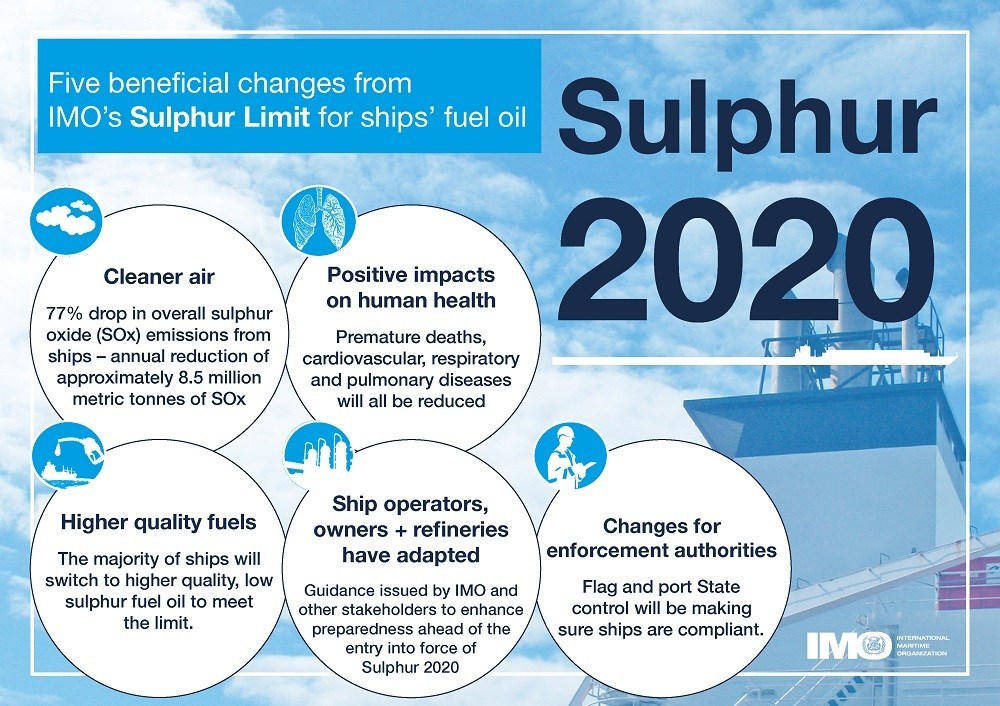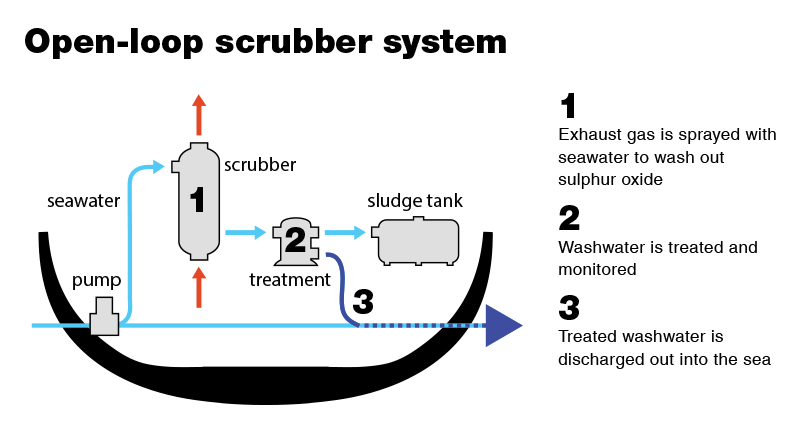
IMO 2020 SULPHUR LIMITS, CHALLENGES, AND BENEFITS: Md. Taifur Rahman (46E)
Background
International maritime organization (IMO) Agreed on 27 October 2016 that from 1 January 2020 Sulphur content of the fuel oil which is used onboard ships shall not exceed 0.5% m/m. This was made mandatory under MARPOL Annex VI.
Regulations and guidelines
Besides the Sulphur limit, the decision was also taken by IMO to impose a ban on the carriage of non-compliant fuel (fuel with a Sulphur content more than 0.5% m/m) from 1st March 2020. However, this ban will not be imposed under the following circumstances.
• Ships using an exhaust gas cleaning system such as scrubber to meet the requirements of the regulation.
• Ships which are conducting tests for new technologies
• Ships reporting non-availability of compliant fuel.
IMO developed a proper guideline for the port state control (PSC) as per resolution MEPC 181(59). The guidelines include that the PSC should carry out document-based inspection and be given a clear ground for detailed inspections which includes sample analysis and other checks to ensure compliance with the new regulation.
Oil sampling points guidelines were given to establish an agreed method of sampling to ensure effective control and enforcement. A designated sampling point is required by MEPC.1/CIR 864.
For fuel suppliers and purchasers’ different guidelines were developed under MEPC.1/CIR 875 to ensure the best practices are being followed during the process. Which aims to reduce quantity disputes and ensure the best qualities.
Under regulation 4 of MARPOL Annex VI the exhaust gas cleaning systems (scrubber) are excepted based on the criteria described on the guideline (resolution MEPC 259(68)). Limit on four parameters of wash water was set in the guideline which are PH, PAH, Turbidity and Suspended particle maters and Nitrate.
Exhaust Gas Cleaning Systems
To fulfill the specific requirements of the regulations three types of scrubber are being used which are generally designed to retrofit.
• Open Loop
• Closed Loop
• Hybrid
Open Loop
In the Open Loop exhaust gas cleaning system, seawater is being pumped by the high capacity VFD operated pumps and passes through the nozzles in the gas cleaning chambers which wash out up to 98% of Sulphur and finally discharge to the sea. To improve the washing capability as per requirement highly alkaline Caustic Soda (NaOH) will be mixed with both exhaust gas and seawater by separate pumping arrangements.
Before passing through the scrubber system there is a separate seawater sampling system that analyzes seawater for pH, and turbidity. Before discharged to the sea wash water analyzing unit analyzes for pH, PAH, and turbidity. A discharge nozzle of seawater is designed in such a way that the pH of seawater within the 4-meter radius of the nozzle will be 6.5.
Exh gas sampling unit measure continuously the SO2, CO2, Sulphur content and SO2/ CO2 ratio.

Close loop
In a close loop cleaning system, wash water is discharged to a tank from where the gas cleaning residue is being separated by special arrangement and the same water is used for cleaning again. In this system, there is no discharge of wash water to the sea. In due course this gas cleaning residue to be discharged to shore facilities.
As per regulation 17.1 of MARPOL Annex VI that each party who undertakes the convention have to ensure adequate facilities to receive these residues without causing any delay to the ship’s operation.

Hybrid system
This is actually a combination of the open and closed-loop cleaning system. As of now some countries raising their concerns about discharging wash water in their territory and imposing a ban for using the open-loop cleaning system.
So, in a hybrid system facilitates the users to operate on closed-loop where the open-loop system is prohibited. However, in due course this gas cleaning residue to be discharged to shore facilities.
As this gives a wide range of facilities which made it expensive than others.

All the system can operate in different operational modes such as
• full load
• reduced load
There is also a selection to choose what area the system shall perform in:
• Out of ECA: Cleaning to 0.50 S% equivalent and pH = 6.5 at 4m from the ship side.
• Inside ECA: Cleaning to 0.10 S% equivalent and pH = 6.5 at 4m from ship side.
• USA ECA: Cleaning to 0.10 S% equivalent and pH = 6.0 at ship side.

Chemical reactions in Scrubber
Seawater used in the gas cleaning process as a main absorbing medium which is alkaline and having a buffer and neutralizing capacity. This also has a large number of dissolved sulphates.
Overall reactions
SO2(g) + H2O(l) = SO32- + 2 H+ …………………… (1)
HCO3- + H+ = CO2(g) + H2O(l) …………….……. (2)
CO32- + H+ = HCO3-
SO32- + 1/2 O2(g) = SO42- …………………………… (3)
NaOH(aq) = Na+ + OH-
OH- + H+ = H2O(l)
• SO2 of seawater reacts with water and acid, H+ ions are produced (reaction 1)
• Bicarbonate and carbonate in the seawater reacts with the released H+ (reaction 2),
• The sulphite will react with the oxygen in the seawater and form sulphate (reaction 3).
• Adding caustic soda (NaOH) to the seawater will increase the neutralizing capacity, last two reactions.
Neutralizing agents
In all three systems, several neutralizing agents are used to improve the performance of the system as per requirement. The commonly used agents are caustic soda (NaOH), sodium carbonate (Na2Co3), magnesium oxide (MgO). Which will be bunkered onboard ship in liquid form.
Use of Scrubbers on US Waters
As per CVC Policy letter 12-04,
• Provided the systems are tested, surveyed, and verified under MEPC 184(59) or MEPC 259(68) and are appropriately granted equivalencies by a flag administration, exhaust gas scrubbers may be used to meet the ECA requirements in the US.
• Non-USA flagged vessels using EGCS to comply with North American and U.S. Caribbean Emission Control Area (ECA) requirements do not need to make a separate notification to USCG before arrival in US waters.
Additional VGP Requirements for Scrubber Wash water
Vessels using an open-loop or hybrid system that will generate an EGCS wash water discharge within 3nm of the US, are subject to additional monitoring and effluent limitations under the 2013 VGP. An excerpt of EGCS requirements from the 2013 VGP is Given below.
• The requirements are normally the same as those in MARPOL Annex VI, the limit of pH is stronger as per VGP.
• The discharge of any scrubber wash water is prohibited in Connecticut State waters.
• EGCS is not authorized to comply with the California requirements
• But if granted by state there is a special research exemption
Practical problems raised after using the scrubber
The scrubber is a whole new machinery for using on ships. In all of the models having some flaws which are coming out after using it on board. Manufacturers are continuously modifying the components to make a perfect seagoing design which will have a good performance during the run. The following problems are observed after using.
• Cracks on the scrubber body
• Exhaust extractor fan failure.
• Damage of motor windings after exhaust gas ingress due to the seal failure.
• Exhaust gas sampling equipment failure
• Exhaust dampers are not operating properly
• Wash water analyzing unit pump failure.
• Low performance on muddy water.
• VFD failure of the seawater pump and exhaust fan.
• Low performance on heavy weather conditions.
Challenges
As the regulation came into force to maintain it the bigger challenge is to maintain a constant supply of VLSFO. So far only 2% of the ships having scrubber installed. Many refineries are yet to gain the capability of producing VLSFO as this fuel needs several advance refining processes to dropdown the Sulphur content. After doing so the cost of fuel oil is also getting higher. Although there is a different way to produce VLSFO from HFO by mixing some additional reagents and less refining. In this process, the cost of fuel doesn’t increase much but there are several incidents reported after using this type of fuel.
According to the International bunker industry association bunker prices (In USD) in various big hubs of the world in mid-January 2020 were as follows.

According to various reports, the price of bunker expected to dropdown 30/40% by the end of the twenties.
Recently a technical circular published by The VISWA GROUP, the following problems were reported over the past few days.
• The vessel has reported trouble of Purifier with heavy sludge formation inside purifiers
• Fuel was frozen in the tank
• Heavy sludge accumulation one of the purifiers shut down on heavy vibrations. For this reason, purifier internal parts damaged
• Few hours of purifying of new VLSFO 0.5% found an excessive quantity of paraffin
• HFO Purifier got a problem with sludge accumulated inside, was not de‐sludging.
• Discharge port for VLSFO purifier blocked by oil sludge
• FO purifier getting choked frequently. slowly turning in to hard asphalt
• Bitumen sludge clogged drain pipe and bowl body, drain passage outside the bowl
• Excess generation of sludge in purifier
• ME Piston ring breakage.
Benefits
As VLSFO is the more refined fuel, by using this we going to achieve more cleaner exhaust. This means this will have less impact on the environment. Most importantly the SOx emission will be reduced dramatically.
According to a report of IMO, the five major benefits are
Cleaner Air
• 77% drop in overall Sulphur oxide (SOx) emissions from the ships-annual reduction of approximately 8.5 million metric tons of SOx.
Positive impact on Human health
• Premature deaths, cardiovascular, respiratory and pulmonary diseases all will be reduced
Higher quality fuel
• The majority of the ships will switch to higher quality, low Sulphur fuel oil to meet the limits.
Ship operators, owner, refineries have adapted
• IMO and other stakeholders’ guidance for enhancing preparedness ahead of Sulphur 2020
Changes for enforcement authorities
• Flag and port state control will be making sure ships are compliant
End of the day it’s time to be a good citizen and by respecting the present regulation we can make our world a better place.
Writer: MD TAIFUR RAHMAN ( BMA, 46/E)
COC MEO-2, MPA
E: rahman.taif1@gmail.com
References
Resolution MEPC.259(68)- 2015 Guidelines For Exhaust Gas Cleaning Systems- IMO
Technical Update 13-2014 / November – Preparing For Low Sulphur Operation-DNVGL
Prevention Of Pollution Of The Sea (Air) Regulations- MPA
The Viswa Group Technical Update 26.12.19
O’BRIEN’S Circular NO: 030-19
www.imo.org







![[নোঙর 2016] আমার সেরা বিদেশ ভ্রমন : নাফিসা মাশহুরা ইরা](http://bdmariners.org/wp-content/uploads/2016/06/Dubai-city-tour-70x70.jpg)




Recent Comments